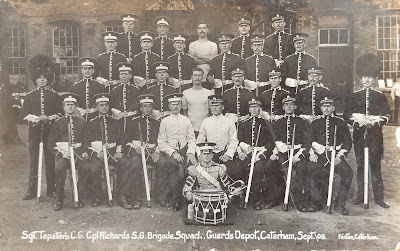11355 Pte John Jarvis Brunt, Coldstream Guards

Arrived Overseas: 22 December 1914. Connection: Memorial scroll, photo, grave photo. John Jarvis Brunt enlisted with the Coldstream Guards on the 2nd September 1914 and by the 22nd December that year he was disembarking in France. He served with the regiment until commissioned on the 31st July 1917 when he joined the Royal Inniskilling Fusiliers. He served with the 12th Battalion but was attached to the 10th Battalion when he was reported missing in action on the 24th March 1918. Later confirmed as killed in action on that date, he was buried in Villers Bretonneux Military Cemetery (XVI B 1). John Brunt was the son of Mr and Mrs James Brunt of 47 Rockley Road, Hillsborough, Sheffield and was 29 years old at the time of his death. His memorial scroll, portrait photo taken in Sheffield, and grave photo have been framed together and hung in the Historic Records office.



.jpg)












.jpg)

